|
Original article: 7 December 2010
last update 14 August 2019
Dear friends,
We come from the village of Assia [Askeia, Ashia] in Cyprus. In the summer of 1974 we were expelled by force from our village by the
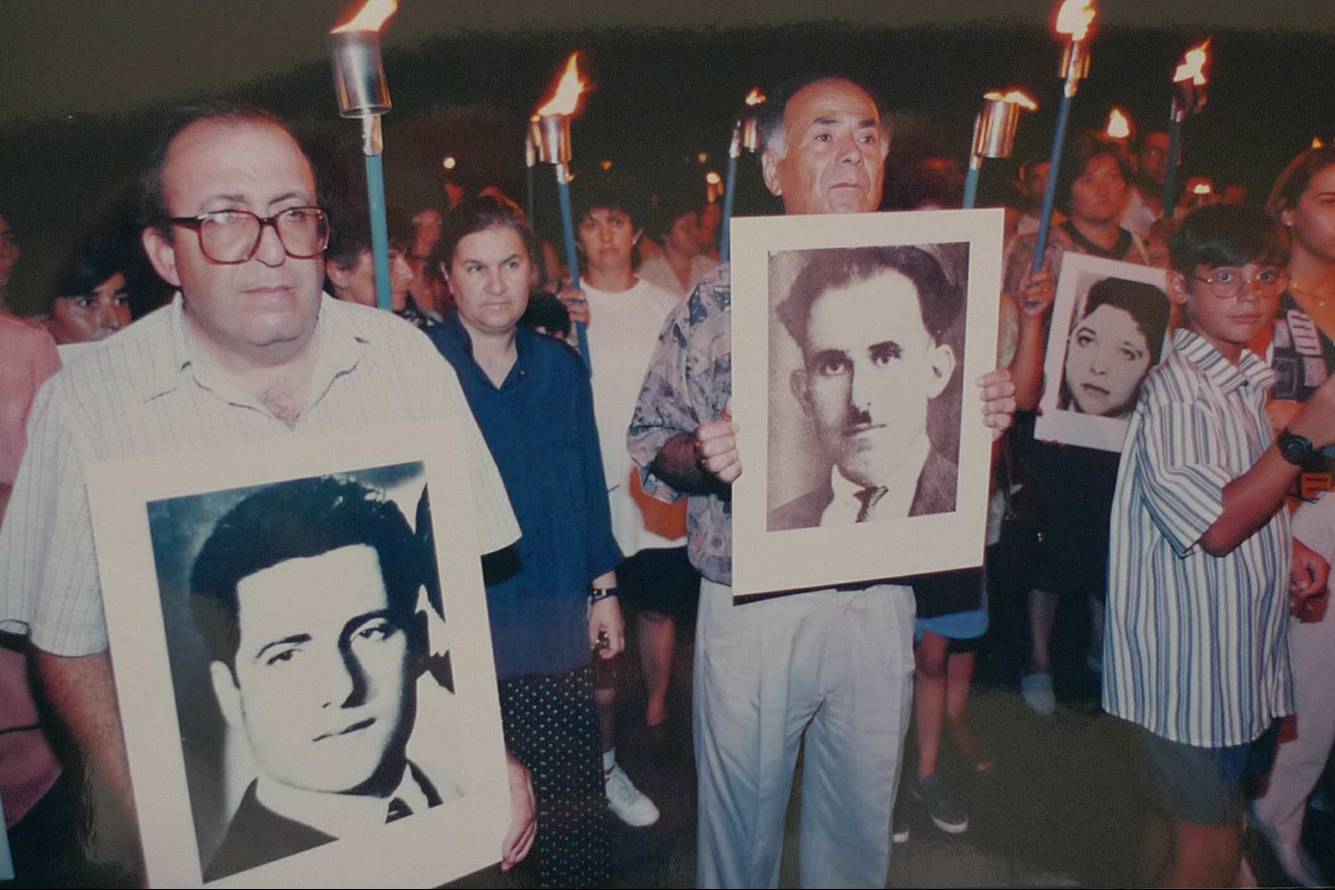
Turkish army, and we were never allowed to return. Turkey provided justification for the invasion of the island on the grounds of restoring the Constitutional order, as dictated by the Treaty of Guarantee signed between Greece, Turkey and the United Kingdom, which was violated by the coup instigated by the Greek Junta against the legitimate President of the Republic, Archbishop Makarios.
Nevertheless, Turkey's 'Peace Operation' turned into a military Occupation for 45 years, of approximately 36 percent of Cyprus that radically altered our lives. The advancing Turkish Army captured our village on 14 August 1974 with dreadful consequences:
13 civilians were executed in cold blood and all males over the age of 15 were arrested.
84 persons from Assia went missing, among them 70 civilians with 8 of them being under the age of 18.
29 civilians from neighbouring villages who took refuge in our village on the 14th of August 1974 were also captured and went missing thereafter.
The Turkish army, aiming to cover up its despicable acts and attrocities committed against innocent civilians, has organized in the 1990's the removal and relocation of the remains of an estimated number of 70 missing persons captured in Assia who were executed and buried in two mass graves in Ornithi.
Women and children were forced to live in appalling conditions full of intimidation and terror while many girls and women experienced the horrors of rape.
Our properties were systematic pillaged and looted.
Between the 23th and 28th of August 1974, all the residents of our village were expelled by force and were never allowed to return to their homes.
Our homes and land was distributed to the Turkish Cypriots and illegal settlers transferred to Cyprus from Turkey.
All the sacred sites of the village, churches and cemeteries were desecrated, pillaged and looted.
285 homes have been completely demolished.
The Turkish army has taken up a large part of the village to set up an army base, extending over 6 square kilometres, where the 28th Mobile Infantry Division is stationed.
We strongly ask for your understanding and support for our cause. We ask you to reject the Ethnic Cleansing policies of Turkey in Cyprus. Please use every means in your disposal and every opportunity you get to make it clear that such policies are not acceptable within the family of the European Union.
We demand to know what happened to the missing persons of our village. Turkey has the answers and should be held accountable. Please help us resolve this humanitarian issue, which in turn will help the healing of old wounds and would aid in any future solution to the Cyprus problem.
Please raise your voice against the systematic destruction of our cultural heritage and demand that it is properly restored.
We dream of the day that all Cypriots, regardless of ethnic origin, colour, religious or political beliefs, will be able to live and enjoy the same rights and freedoms that all European citizens enjoy. We ask for your solidarity and support.
|
Turkish Policy on Cyprus: Continued violation of human rights and systematic destruction of our cultural heritage
|
The case of Assia [Askeia, Ashia] village

|
|
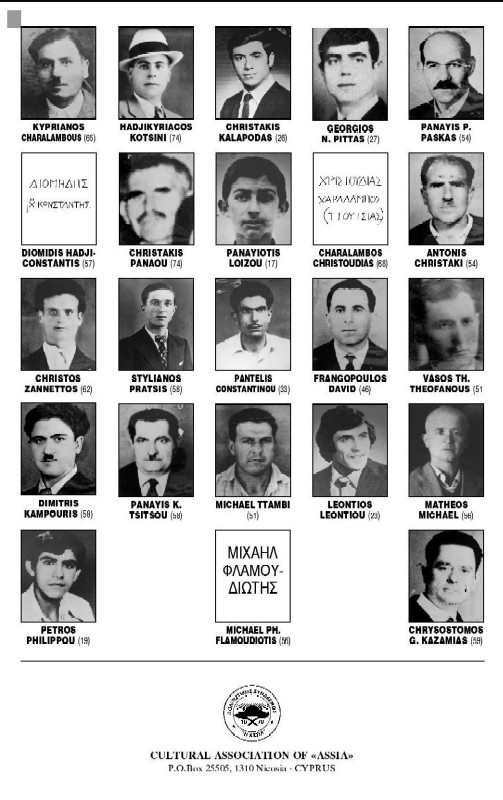
The missing persons from Assia
The list includes 70 civilians and among them 8 youths below the age of 18.
Most noticeable is the case of the Englezou family with 7 family members missing.
|
|
- A war crime that remains unpunished. It is well documented, with numerous testimonies, that among the civilian prisoners, 52 persons who were over 50 years of age, were transferred twice to a prisoners of war detainee camp (Pavlides Garage) in the outskirts of Nicosia, but were rejected both times due to their age. Orders were given to transfer them back to their village to join their families. These men were last seen on 21 August 1974, the day of their second transfer to the Pavlides Garage. None of them has ever returned.
The case of the mass murder of 70 missing civilians in Ornithi - captured in Assia on 21 August 1974
This was the largest sub-group of the 105 missing persons (official statistics) who disappeared in Assia.
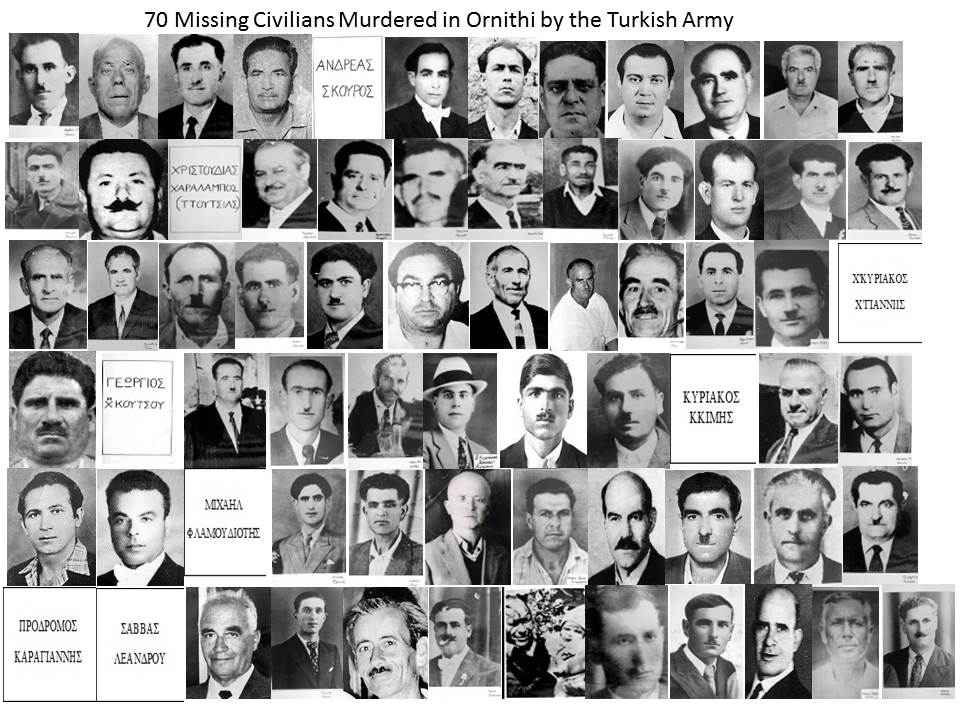
Circumstances of disappearance
On 21 August 1974, Turkish soldiers accompanied by Turkish Cypriots, whose names we know, arrested all the men and young boys remaining in the village. On the same day, according to testimonies of eyewitnesses, 107 persons were loaded on 3 lorries and under guard by Turkish soldiers were driven to the Turkish quarter of Nicosia, Pavlides garage - the temporary place of captivity of Greek Cypriot Prisoners of War prior to their transfer to Turkish prisons in mainland Turkey. The Turkish Cypriot police in charge of Pavlides garage selected 37 persons, below the age of 50, who were detained in the said garage. The remaining 70 civilians were not detained and orders were given to their guards to return them to Assia, apparently due to their advance age. 52 of the said individuals were residents of our village and the remaining 18 residents of neighbouring villages who were also captured in our village.
Mass graves in Ornithi
In the spring of 2009, the Committee on Missing Persons in Cyprus (CMP) conducted a search in the Ornithi area on the outskirts of Afania village, situated about 4 km west of Assia, which lasted for more than a year. Four burial sites were disinterred, two of which were water wells and the sites of mass graves. According to official briefings, the remains identified by DNA testing in those two mass graves have so far confirmed the presence of 68 of those individuals, but anthropological studies have given an indication of the presence of 70 individuals that matches the list of civilians who were captured in Assia on 21 August 1974 as described above.
Organised removal of remains to unknown location
Other evidence that emerged from the search in the Ornithi area was that the two mass graves had been previously exhumed. The human remains were removed and transferred elsewhere, apparently in an effort to hide the evidence of a mass murder. The CMP managed to recover only seven complete or nearly complete skeletons.
For the remaining missing persons in the two mass graves, as we have been officially briefed and also witnessed during our visit to the Anthropological Centre in the Nicosia Airport area in June 2014, only a very small number of bones or bone fragments have been discovered. In a number of extreme individual cases the findings involve bone material of just a few centimetres.
Latest developments regarding the Ornithi mass murders: On 17 November 2017, the Turkish Cypriot member of the CMP, Mrs Gulden Plumer Kucuk and her assistant Mr Murat Soysal, officially informed the Committee of the Relatives of the Missing Persons of Assia that according to their investigation they believe they have credible information that the remains of our missing relatives were transferred, approximately during the perioud 1995 - 96, to the garbage dump site in the area of Dikomo which was the primary landfil site of the occupied northern part of Nicosia and its suburbs. The site remained in use until the early 2000s and was consequently restored environmentally through funding from the European Union. The CMP has expressed its commitment to examine all the facts surrounding the landfil site and to design an investigation plan. To this day no firm plan has been drawn up. The relatives of the missing persons insist that a full investigation is conducted to locate the remains of their loved ones.
The role of Turkey
The massacre of the 70 civilians at Ornithi by the Turkish army has been documented with appaling detail through the testimony from O. Saat, who was serving in the 1st battalion of the 21st Artilery Division of the Turkish army, in the book written by Roni Alasor, "Διαταγή Εκτελέστε τους αιχμαλώτους", εκδόσεις Καστανιώτη, 2002. pages 117-119.
The findings from the disinterment conducted by the CMP gave uncontested evidence that the disappearance of the remains from the mass graves in the Ornithi area was a result of a large scale operation which was conducted in an organised manner that entailed the use of heavy machinery, trucks and most likely many people working for days at a small distance from the village of Afania and the huge army base in Assia, hosting the headquarters of the 28th Infantry Division of the Turkish Army. Given the nature and scale of the operation, we strongly believe that it was conducted under the initiative or at least with the full knowledge of the Turkish Army. Therefore, they must have clear knowledge of the history and whereabouts of the transferred remains.
Further evidence that supports the above conclusion is the findings from exhumation work on various locations on the island. Indicatively we mention the cases of mass graves in Ayios Ilarion, Kornokipos, Afania, Assia-Ornithi, and most recently Lapithos, one of the biggest mass graves on the island, all of which have been previously removed.
All of the above provide strong evidence that this strategy was planned, organised and executed at a very high level and the intent was to eradicate the evidence of war crimes committed by the Turkish army in Cyprus in the summer of 1974.
| Strong Resolution by the European Parliament Condemning Turkey |
|
|
Regarding the mass graves of the missing persons of Ashia {Assia} in Ornithi village in the occupied part of Cyprus
On 12 February 2015, following a 30 minute discussion, the plenary of the European Parliament adopted resolution RC8-0150/2015 of the joint motion on the case of the mass graves of the missing persons of Ashia in Ornithi village in the occupied part of Cyprus.
Present Members of Parliament: 648
Voted:
For 543 (83.8%)
Against 43 ( 6.6%)
Abstentions 62 (10.0%)
You can read the Resolution in the following link: 1) in English 2) in Greek
Progress with the identification of missing persons
The CMP has thus far had delivered the remains of 34 missing persons from Assia to their families for proper burial. In addition, the remains of another 18 missing persons, from neighbouring villages, who were also captured in Assia, have been delivered to their families and and were properly buried.
|
|
Turkish Occupation of Assia
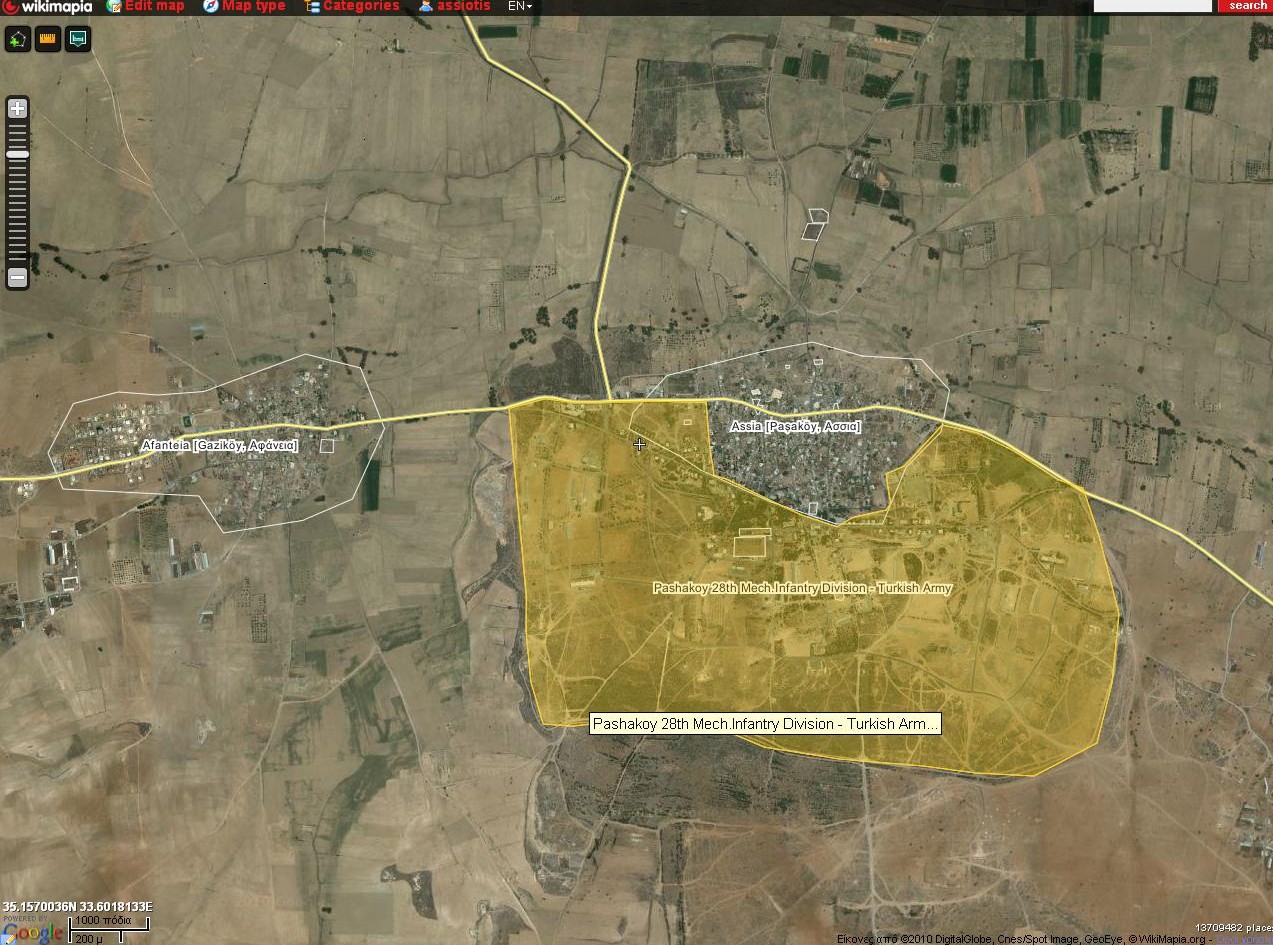
(Satellite view if Assia today, source: wikimapia.com)
|
|
Today the southern part of the village is enclosed by high walls and barbed wire and guarded by armed Turkish soldiers. This vast military area , shown in yellow above, comprises of:
- hundreds of houses belonging to the people of Assia,
- two churches, of Saint Theodore and Saint Spyridonas,
- the primary school of Assia which in 1974 accommodated about 400 students and 12 teachers,
- two football fields belonging to the local teams,
- two movie theatres, and
- a very large rural area in the south of the village.
|
|
Destruction of our cultural heritage - A formal policy of the Turkish government
Church of Saint Mary of Assia

The Byzantine church of St. Mary dates back to the Venetian era (1489 - 1571 AD) in Cyprus and it is probably one of the oldest surviving Christian monuments in our region. In this church, the residents of Assia would go and pray, when our community was built around the church in medieval times.
(Church of St. Mary, photo from our archives)
All the valuable items of the church, ancient icons, the iconostasis and sacred objects were looted. The church currently lies desecrated in ruins and its northern wall has partly collapsed or has been demolished.
|
|
The church sits on the flat plain in the proximity of the Gialias river [12] and is often exposed to serious flooding. The lack of maintenance of the protective wall barrier around it, and the collapse of its northern wall, leaves the church seriously exposed to natural forces and it now runs a serious risk of total collapse and destruction.
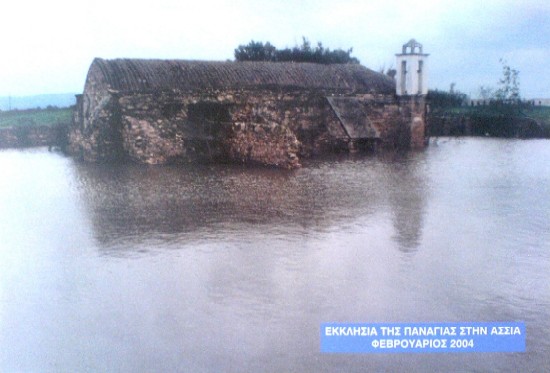
(The flooded church of St. Mary, photo: Michalakis Pelides, 2004)
|
|
Cemeteries of Assia

The two cemeteries in the village, next to the church of St. Mary, have been desecrated and left in ruins and many graves are standing open to this day. The state of the monuments and crosses cause anguish to the relatives of the deceased and repulsion to the viewer.
|
|
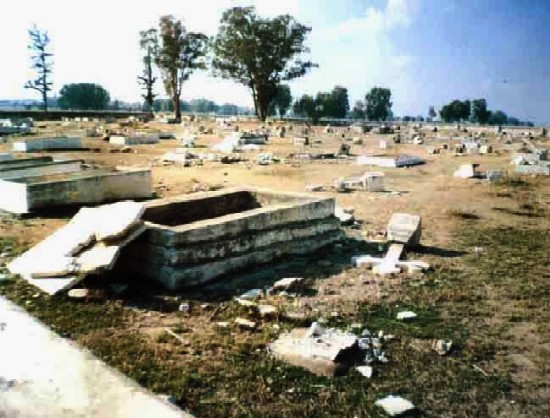
(Cemeteries of Assia, photos from our archives)
|
|
Church of Saint George of Assia

The church was built in 1861 over a sixty-five day period, in the lower parish of Assia, mainly through voluntary work. The short time of completion was due to the intense competition that existed between the two parishes of the village, which both began construction of their own church simultaneously.
|
|

The Turks, following the capture of Assia, looted and desecrated the church. All the icons, sacred vessels and the iconostasis were stolen and professional looters probably removed the wall paintingof Saint George on the northern side of the church. They also demolished the portico and the external stone built wall fencing.
(Church of St. George, removal of wall painting, 2009)
|
|
The church of St. George was converted into a storage area for hay and the surrounding areas into a stall for sheep.
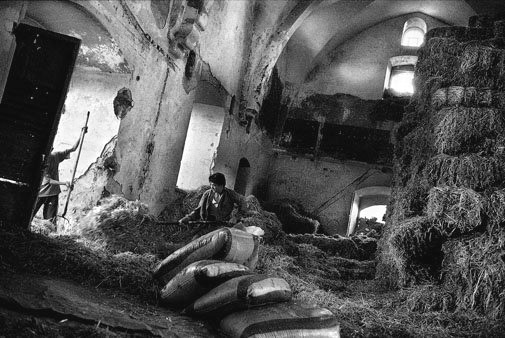
(Photo: Anikitos Hadjicharalambous, 2003)

(Photo: Anikitos Hadjicharalambous, 2003)
In 2004 the church building was emptied of the hay, and the sheep farm was moved a short distance away from the church. Whatever is left of the building today plays host to the wild pigeons in the area and graffiti.
The photo below portrays the inside of the church of Saint George as it is today.
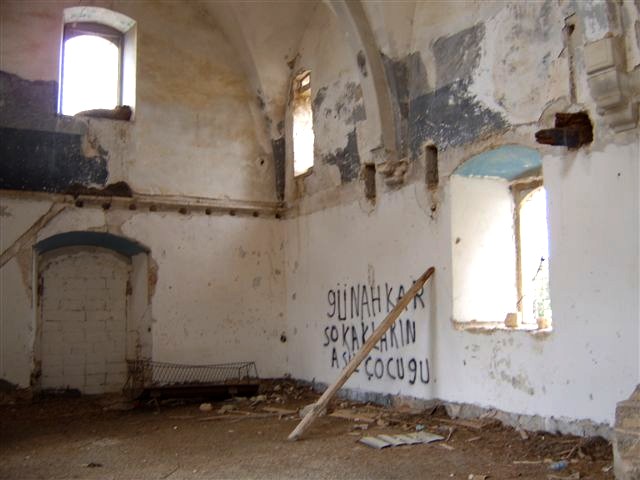
(Photo: Christoforos Skarparis, 2009)
|
|
The photo below shows the engraved stones taken from the now demolished portico and stone-built fence. They currently form a part of a sheep stall, a short distance from the church.
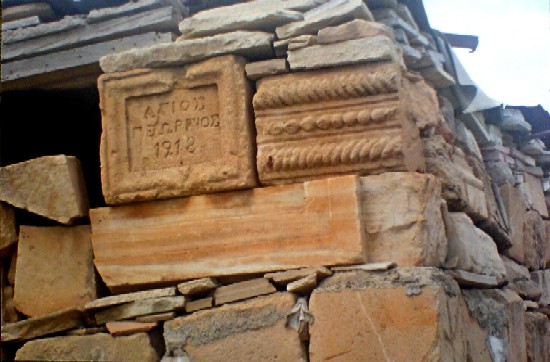
(Photo: Mary Pelekanou, 2009)
|
|
Church of Saint John the Baptist of Assia

The church was built in 1861 in a period of sixty-five days (July to September), in the upper parish of our community, particularly through voluntary work.
The church was looted and desecrated before the residents were forcefully expelled from the village by the Turkish army in August 1974 and consequently converted into a mosque as shown in the photo below.
|
|
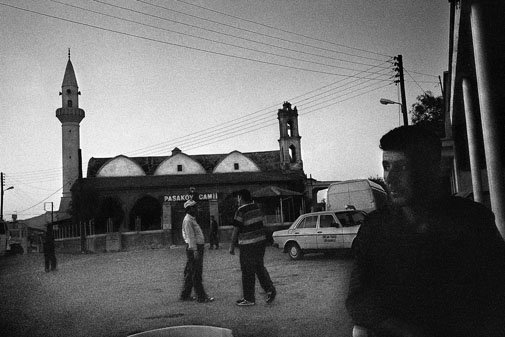
(Photo: Anikitos Hadjicharalambous, 2003)
|
|
The search for our looted cultural heritage - The recovery of the icon of St. John the Baptist
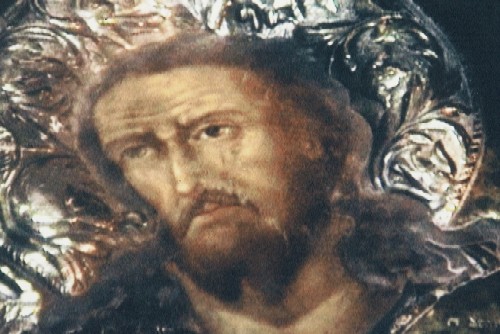
After the partial lifting of the restriction of movement in 2003, a Greek Cypriot family from Assia located the icon of Saint John the Baptist in their house. It was kept there for almost 33 years by the Turkish family living there after they had located the icon in a garbage dump outside the village. The cooperation of the two families gave positive results. With great personal risk of those involved, the icon was transferred to the free areas of the Republic of Cyprus.
|
|
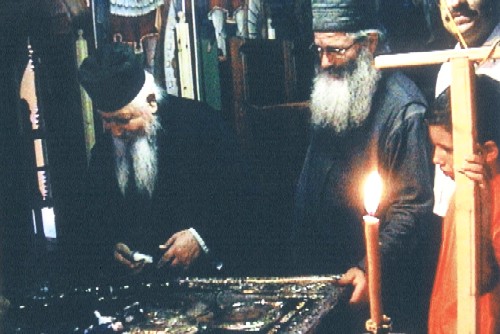
After proper cleaning and preservation at the monastery of Stavrovouni, the icon was handed over to the community of Assia in a solemn and highly emotional ceremony on 27 July 2003. The icon is presently hosted at the Church of Saint Andreas at Plati Aglantzia, Nicosia.
|
|
Church of Saint Theodore of Assia

The church was built in the southern part of the village. Construction work began in 1942 and was completed in 1962. Today the church lies in the military zone controlled by the Turkish army. The present condition of the church is not known since the area is inaccessible to the public.
|
|
The discovery in the bazaars of Turkey

M. Kozakerides, a Greek national, discovered and purchased the Holy Gospel of Saint Theodore of Assia, in the bazaars of Trabzon on the Black Sea coast of Turkey. The gospel was looted by the Turks in 1974. His thoughts turned to the people of Assia, the rightful owners of the holy gospel. On 26 July 2009 in a solemn ceremony which took place at the Church of Saint Andreas in Plati Aglantzia, Mr. Kozakerides delivered the gospel to the Community of Assia.
|
|
Church of Saint Spyridonas of Assia

The church was commissioned by Michael Kashalos, the renowned naive painter-sculptor of Assia, and was built in the yard of his house. The construction of the church began in 1969 at the expense of the folk artist and was completed in about two years.
|
|
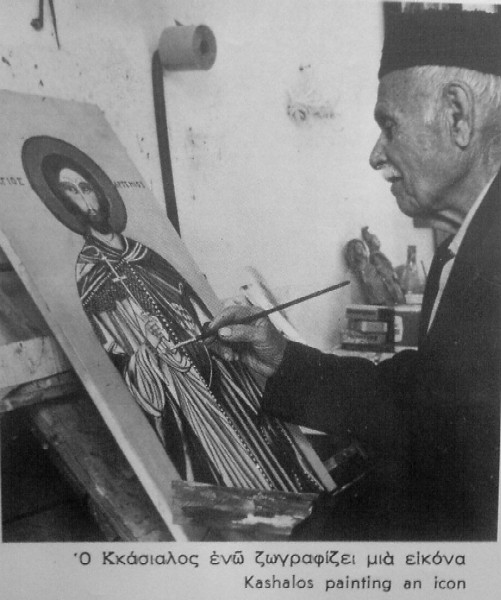
Michael Kashalos fully dedicated his limited resources, great love and artistic skill to complete the church. He undertook the challenge to paint the icons and other religious depictions inside the church. His vision and dedication was brutally disrupted when the Turkish army entered the village on 14 August 1974. The 89 year old artist was robbed and then struck with the butt of a rifle on 18 August 1974. He was carried to the free areas of the Republic of Cyprus on 24 August 1974. He did not withstand the hardship and he passed away six days later, on 30 August 1974. [2,13]. Kashalos' artworks, which he hosted in his humble home-workshop, and the Church of St. Spyridonas, were looted and their fate is unknown.
|
|
The Youtube video below is an excerpt from the movie "Attilas 74", by Michael Cacoyiannis, which presents the horror and concequences of the Turkish invation on Cyprus and its people. The viewer can see between the second and fourth minute a short presentation of Michael Kashalos and his work by the renowned Cypriot artist, Adamantios Diamantis, as well as a short testimony, by his wife Irini, relating to the circumstances surrounding his death.
|
|
The church Kashalos built is currently located within the military zone and has been converted into an army depot of the Turkish army.

(Church of St. Spyridonas, Assia Today, photo archive of Politistikos Syndesmos "Assia")
|
|
Turkish aggression in Cyprus in 1974 was brutal and indiscriminate, as the experience of the civilian population of Assia and the case of Kashalos in particular clearly indicate. Turkey had put in place a systematic mechanism of fear and destruction, which aimed at the complete demoralisation of all civilians, and their plan was only completed after the forced expulsion of all the residents from their homes.

Painting by Michael Kashalos "Watering the Fields")
|
|
References
1. www.assia.org.cy the web page of the Cultural Association of Assia.
2. Cultural Association of Assia, «ΑΣΣΙΑ ζωντανές μνήμες βαθιές ρίζες μηνύματα επιστροφής»,
Nicosia 1983.
3. Costas Chr. Tziortzis, «Άσσια μέρες συμφοράς Αγώνας για επιστροφή», Nicosia 1989.
4. http://www.missing-cy/index2.html the web page of the Cyprus Committee of undeclared
prisoners of war and missing Cypriots.
5. Satelite map wikimapia http://wikimapia.com.
6. Anikitos Hadjicharalambous Photographer, «Visitors in their Land», Nicosia, 2008.
7. Photographic Archive of Politistikos Syndesmos "Assia" (The Cultural Association of "Assia")
8. Recent photographs of Saint George taken by Mary Pelekanou and Christoforos Skarparis.
9. Larnaca Municipality, Pierides Foundation, Daphne Nikita «Michael Chr. Kashalos, the hidden
fascination of painting», Copyright © 2000.
10. Costas Chr. Tziortzis, Άσσια Περιμένοντας την Ανάσταση, Nicosia 2009.
11. Documentary Film, "Missing Fate Unknown", Cyprus Broadcasting Corporation.
12. W. C. Lowdermilk, Conquest of the Land Through Seven Thousand Years, published as USDA
Bulletin No. 99, U.S. Department of Agriculture Natural Resources Conservation Service, 1939.
13. Yianni Nika, "Κκάσιαλος", Nicosia 1983.
Related articles posted on this web page:
Acknowledgements
Research and writing of the above report was done by Yiannos Demetriou. Savvas Tsikkouris and Ioanna Hadjicosti provided their constructive input and very useful comments.
Note: this article is amended from time to time as deemed necessary as new information surfaces. We always strive to give the most accurate facts available on the time of the last update.
|
|








